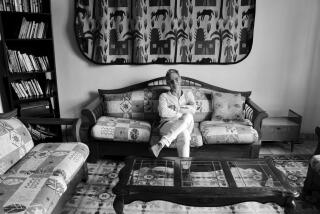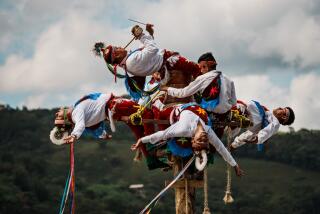Chichen Itza: The Rome of Mexico?
- Share via
CHICHEN ITZA, Mexico — The Red Jaguar with jade eyes sits as a throne in the pyramid castle, imperiously supporting new archeological beliefs that these majestic ruins may have been the Rome of their ancient world.
Already Chichen Itza, largest and most famous of all the Maya and Toltec ruins yet uncovered in Mexico’s Yucatan Peninsula, has become a traveler’s destination, not just an excursion for a day from Merida or Cancun.
Its importance and fascination will grow with continuing studies indicating that even the Pyramid of Quetzalcoatl near Mexico City may have had its cultural origins here in Chichen Itza, instead of the reverse flow of history so long presumed.
Visitors will be increasingly tempted to stay for at least one overnight in order to step back into the story of a thousand years ago in a more leisurely way.
Gracious and moderately priced resort accommodations are close to the ruins. Hours of walking around the ruins and climbing pyramid steps can be followed by a dip in a swimming pool, then a chance to relive the day during cocktail hour and dinner.
Not an Expedition
Getting to Chichen Itza isn’t an expedition, as many first-time travelers to the Yucatan expect it to be. Along the well-paved trans-peninsular Mex 180 highway, the site is about 120 miles west of Cancun. We found the driving time comparable to the trip between Los Angeles and Palm Springs. Eastward from Merida, capital city of the Yucatan, it is about 75 miles.
Air-conditioned sightseeing buses make the trip daily from Merida and Cancun. Buses from Merida also bring visitors to the evening sound and light show at the ruins. Local airlines offer short flights from Cancun and Merida.
However the traveler gets here, you may take the adventure at your own walking or climbing pace, either with a guide or by following the excellent do-it-yourself guide booklet available at the entrance.
The extensive ruins stretch for about two miles on both sides of the highway (which is closed to traffic through the historic area).
The great plaza on the northern side of the highway reflects far more extensive development than the Toltec Quetzalcoatl ruins at Tula about 50 miles north of Mexico City.
Pyramid Dominates
This entire plaza and the ruins on both sides of the highway are dominated by the pyramid-shaped Castle of Kukulcan, which early Spanish explorers called El Castillo, the castle. It rises above the plain as dramatically as a pyramid of ancient Egypt, seeming much higher than its 75 feet.
Like the higher pyramid we just visited at still relatively unexplored Coba, El Castillo challenges a visitor to climb its steep steps. The view from the top overlooks the unforgettable wonder of the entire Chichen Itza site.
Inside El Castillo you can climb the steps of an earlier pyramid. In one chamber you’ll meet the Red Jaguar with its jade eyes. The inner pyramid is believed to have been built by the more peaceful Maya before the arrival of the Toltec warriors around the 9th Century, although the Toltecs may have added their own touches to it.
As you listen to a guide and then follow your self-guide materials, the wonder of El Castillo grows. So does the mystery of the interweaving Maya and Toltec cultures, which formed part of the base on which the Aztecs began to build their pre-Hispanic civilization in the 14th Century.
Solar Understanding
The pyramid was built with great awareness and understanding of the solar system. Its original number of steps counted the 365 days of the year. Shadows still precisely record the first day of spring, the first day of autumn.
Below El Castillo pyramid is a ball court bigger than a football field, used for contests that seem to have been as lacking in mercy as any contests between Roman gladiators. Two teams would meet in a ballgame that somewhat resembled soccer, and the losers would be decapitated.
The power of the Toltec warriors is symbolized in two Temples of the Jaguars, decorated with jaguars around warriors poised with spears and shields. The Platform of Venus shows Quetzalcoatl reborn as the morning star; he is also identified in mythology as both a king and originator of art and learning, known to the Maya as Kukulcan.
A dozen sculptures of Chac Mool, the Rain God, are among the most striking encounters as you walk around Chichen Itza. They are half-seated, half-reclining figures in stone that seem to be gazing pensively at you out of centuries long ago.
They reminded us of figures we had seen around the Pyramids of Egypt, and we wondered if the Mayans had ever reached out that far in their seagoing commerce. The Temple of Chac Mool is part of the colonnaded Temple of the Warriors, close to the Court of a Thousand Columns where aristocracy may have lived.
Rituals in Bas Relief
Rituals of sacrifice are re-created in bas relief figures at the Ball Park, on Tzompantli, the Wall of Skulls, and at the Well of Sacrifices.
Fascinating bits of hieroglyphic inscriptions, paintings and masks of the Rain God adorn other structures. One reminded the Spaniards of a church, and they called it La Iglesia; another complex they named is known in English as the Nunnery.
A walk of about half a mile beyond the ruins on the south side of the highway leads to a third and smaller cluster known as Chichen Viejo, Old Chichen, not yet restored but rewarding in unexpected encounters with carved figures and Rain God faces.
At Coba we had enjoyed Hotel Villa Arqueologica, and we found another such hotel here, with comparable amenities of comfortable rooms, a fine restaurant and relaxing bar lounge, pool and tennis court. Rates for its 40 air-conditioned rooms are in the same range, about $30 double, and indicate prices you can expect to pay around Chichen Itza.
Hotel Mayaland has about 60 rooms with balconies and cottages set in landscaping of flower gardens and fountains, which also set off the swimming pool. Hacienda Chichen Hotel has a cluster of 20 cottages around a restored 17th-Century hacienda. Mision Chichen Itza has decorated its 40 rooms in Mexican colonial style. Close by in a garden setting is Piramide Inn, with about the same number of comfortable and air-conditioned rooms. Each of these resort hotels has a restaurant and bar lounge.
On our return to Cancun we stopped about three miles east of Chichen Itza to enter Balankanche Cave, which had remained sealed for a thousand years until it was opened about 25 years ago. Walking and stooping low, we entered the domed chambers where the Rain God was worshiped, beside a pool formed by an underground river.
Blind fish swim tranquilly in the long-forgotten pool, around which incense was once burned to the Rain God. This, too, was part of the Red Jaguar’s empire.
More to Read
Sign up for The Wild
We’ll help you find the best places to hike, bike and run, as well as the perfect silent spots for meditation and yoga.
You may occasionally receive promotional content from the Los Angeles Times.






